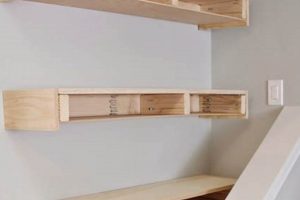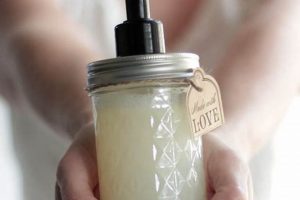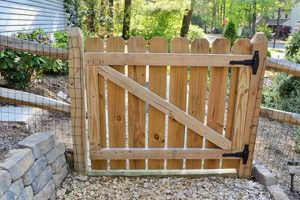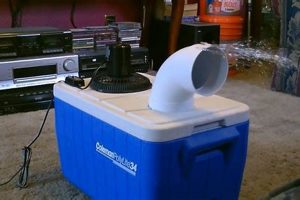Creating a personal bathing space that utilizes vapor for therapeutic purposes can be achieved through various methods. These approaches range from simple adaptations within an existing shower enclosure to more elaborate construction projects. A common example involves sealing a shower area and introducing a portable steam generator to increase humidity and temperature.
The advantages of establishing such a space include potential stress reduction, muscle relaxation, and improved respiratory health. Historically, vapor bathing has been practiced across numerous cultures for its perceived cleansing and wellness properties. The convenience and cost-effectiveness of a self-constructed alternative can make these benefits more accessible.
Subsequent sections will explore the different techniques, materials, and safety considerations involved in building a customized vapor bathing environment. This guide provides essential information for individuals considering the creation of their own personal sanctuary.
Construction and Maintenance Guidance
The following guidelines provide essential information for the safe and effective creation and upkeep of a personal vapor bathing area.
Tip 1: Enclosure Sealing: The integrity of the enclosure is paramount. Gaps and cracks must be meticulously sealed with moisture-resistant materials, such as silicone caulk, to prevent vapor escape and potential water damage to surrounding structures. Regular inspection and maintenance of these seals are critical.
Tip 2: Steam Generator Selection: The steam generator should be appropriately sized for the enclosure’s volume. Insufficient capacity results in inadequate vapor production, while excessive power consumption increases energy costs. Consult manufacturer specifications for optimal sizing.
Tip 3: Ventilation Considerations: Proper ventilation is crucial outside the enclosure to prevent moisture buildup and mold growth. An exhaust fan in the adjacent bathroom is recommended to remove excess humidity generated during and after vapor bathing sessions.
Tip 4: Material Selection: Opt for materials resistant to moisture and high temperatures. Ceramic tile, stone, or acrylic are suitable choices for interior surfaces. Avoid porous materials like untreated wood, which can harbor mold and deteriorate over time.
Tip 5: Electrical Safety: All electrical connections must adhere to local building codes and be performed by a qualified electrician. Ground fault circuit interrupters (GFCIs) are essential for protecting against electrical shock in wet environments.
Tip 6: Water Quality: The quality of water supply significantly impacts steam generator longevity. Hard water causes mineral buildup within the generator, reducing its efficiency and lifespan. A water softener or filtration system may be necessary in areas with hard water.
Tip 7: Regular Cleaning: Consistent cleaning of the enclosure and steam generator is vital for hygiene and performance. Use mild detergents and follow manufacturer’s instructions for descaling the generator to remove mineral deposits.
Adherence to these guidelines ensures a safe, functional, and long-lasting personal vapor bathing environment. Careful planning and consistent maintenance are key to realizing the intended benefits.
The subsequent section will address potential risks and safety precautions associated with vapor bathing, emphasizing responsible usage.
1. Sealing Effectiveness
Sealing effectiveness is a foundational element in the construction of any personal vapor bathing enclosure. Its primary function is to contain the generated vapor within a defined space, preventing its escape and minimizing potential damage to surrounding structures. The direct consequence of inadequate sealing is the diffusion of humid, high-temperature air into areas not designed for such conditions. This can lead to a range of problems, from cosmetic issues like peeling paint and warped wood to more severe structural concerns, including mold growth and compromised building integrity. The efficacy of the enclosure directly impacts the overall usability, safety, and longevity of the installation.
The selection of appropriate sealing materials and techniques is crucial. Silicone caulk, specifically formulated for wet environments, is commonly used to seal gaps and joints. Proper application involves thorough cleaning and drying of the surfaces to ensure optimal adhesion. Overlapping materials and multi-layered approaches are implemented in areas of high stress or exposure. For example, corners and junctions between different building materials are particularly vulnerable and require meticulous attention. Ongoing maintenance, including regular inspection and reapplication of sealant where necessary, is integral to preserving the integrity of the vapor barrier. Without effective seals, the energy efficiency of the enclosure will also be reduced, resulting in increased operational costs as more energy is required to maintain the desired temperature and humidity levels.
In summary, sealing effectiveness is not merely a peripheral consideration, but a central requirement for the successful implementation of a personal vapor bathing space. Its impact spans structural protection, energy conservation, and overall system performance. By prioritizing proper sealing techniques and materials, individuals can significantly enhance the safety, durability, and cost-effectiveness of their enclosure. Failures in sealing precipitate a cascade of negative consequences, ultimately undermining the intended benefits of the project.
2. Generator Capacity
Generator capacity represents a critical determinant of performance and user satisfaction within a personal vapor bathing enclosure. Selecting a generator with inadequate or excessive capacity introduces inefficiencies and potential hazards. The unit’s ability to generate sufficient vapor volume, measured in kilowatts (kW), directly impacts the user’s experience and the system’s operational effectiveness. Therefore, careful calculation and consideration of enclosure size and environmental factors are essential.
- Enclosure Volume and Vapor Density
The physical dimensions of the enclosure directly dictate the required output of the generator. Larger enclosures require proportionally more vapor to achieve the desired humidity levels and maintain a consistent temperature. Inadequate capacity leads to extended heating times and a suboptimal vapor density, compromising the therapeutic benefits. For instance, a generator designed for a small shower stall will fail to adequately fill a converted walk-in closet, resulting in a lukewarm, unsatisfactory experience.
- Heat Loss and Insulation
The degree of insulation in the enclosure affects the rate of heat loss and, consequently, the generator’s workload. Poorly insulated enclosures
require higher capacity generators to compensate for heat dissipation, leading to increased energy consumption and potential wear on the unit. Conversely, well-insulated enclosures require less power to maintain temperature, allowing for a smaller, more efficient generator. This illustrates the importance of assessing the enclosure’s thermal properties before selecting a generator. - Steam Distribution and Dispersion
Generator capacity influences the effectiveness of steam distribution within the enclosure. A higher capacity generator can provide a more forceful and uniform dispersion of vapor, ensuring consistent temperature and humidity throughout the space. Insufficient capacity may result in uneven distribution, with some areas remaining cooler and drier than others. Proper nozzle placement and generator power are thus intertwined in achieving a comfortable and effective vapor bathing environment.
- Operational Efficiency and Longevity
Operating a generator beyond or below its intended capacity reduces its lifespan and operational efficiency. Overloading a small generator leads to premature failure due to overheating and stress on its components. Conversely, using an excessively large generator in a small space results in energy waste and potentially dangerous temperature fluctuations. Selecting the appropriate capacity ensures optimal performance, energy conservation, and extends the unit’s operational life.
The interplay between enclosure volume, insulation, steam distribution, and operational demands highlights the importance of accurate generator capacity assessment in realizing the desired benefits of a personal vapor bathing space. Inadequate planning in this area inevitably leads to compromised performance, increased operational costs, and potential safety hazards, undermining the overall viability of the project.Accurate matching of generator capacity to the specifics of the steam room ensures that the desired vapor density and temperature are achieved, thereby maximizing the therapeutic value and longevity of the system.
3. Material Resistance
Material resistance constitutes a cornerstone in the construction of a personal vapor bathing environment. The inherent properties of selected materials directly influence the longevity, safety, and overall performance of the enclosure. Specifically, the ability to withstand prolonged exposure to high humidity and elevated temperatures is paramount, determining the structural integrity and hygienic conditions within the space.
- Moisture Permeability and Degradation
Materials with high moisture permeability, such as untreated wood or certain types of drywall, are susceptible to water absorption. This absorption leads to swelling, warping, and ultimately, structural degradation. Furthermore, trapped moisture fosters the growth of mold and mildew, creating unsanitary conditions and posing potential health risks. Impermeable materials like ceramic tile, porcelain, or specific acrylic formulations prevent moisture penetration, preserving the structural integrity of the enclosure and minimizing the risk of microbial growth.
- Thermal Expansion and Contraction
Fluctuations in temperature induce expansion and contraction in building materials. Materials with significantly different thermal expansion coefficients can create stress points within the structure, leading to cracking, joint failure, and compromised seals. Selecting materials with similar thermal expansion properties minimizes these stresses and ensures the long-term stability of the enclosure. For instance, using a combination of glass and certain metals with disparate expansion rates can result in stress fractures and leaks over time.
- Chemical Stability and Corrosion Resistance
The high humidity and elevated temperatures within the enclosure can accelerate chemical reactions and corrosion in certain materials. Metals prone to oxidation, such as untreated steel, will rust and weaken. Similarly, some plastics may degrade or release harmful chemicals under prolonged exposure to heat and moisture. Corrosion-resistant materials, including stainless steel, certain treated alloys, and specific polymers, are essential for ensuring the long-term durability and safety of the vapor bathing environment.
- Cleanability and Hygienic Properties
The selection of materials directly impacts the ease of cleaning and maintaining hygienic conditions within the enclosure. Porous materials can harbor bacteria and are difficult to disinfect thoroughly. Non-porous surfaces, such as smooth ceramic tile or acrylic, are easier to clean and sanitize, preventing the buildup of harmful microorganisms. The use of antimicrobial additives in certain materials further enhances their hygienic properties, minimizing the risk of infection and promoting a healthier environment.
The collective influence of these material properties underscores the critical role of informed selection in constructing a safe, durable, and hygienic personal vapor bathing space. Neglecting material resistance considerations leads to premature degradation, potential health hazards, and ultimately, the failure of the DIY project. Prioritizing the use of moisture-resistant, thermally stable, chemically inert, and easily cleanable materials ensures a long-lasting and enjoyable vapor bathing experience.
4. Ventilation Adequacy
Ventilation adequacy is inextricably linked to the functionality and safety of a do-it-yourself vapor bathing enclosure. The fundamental principle at play is the management of moisture and temperature differentials created during operation. Without adequate ventilation in the surrounding environment, moisture migrates into adjacent spaces, leading to conditions conducive to mold growth and structural deterioration. The causal relationship is direct: insufficient air exchange exacerbates humidity levels beyond the capacity of standard building materials to withstand, resulting in long-term damage. An improperly ventilated vapor room project can manifest as peeling paint in adjacent bathrooms, warped door frames, or, more seriously, hidden mold infestations within wall cavities. The importance of this aspect cannot be overstated.
Effective ventilation strategies involve both source control, aiming to minimize moisture release, and exhaust mechanisms to remove saturated air. For example, installing a high-CFM (cubic feet per minute) exhaust fan in the room adjacent to the vapor enclosure provides a critical means of extracting moisture-laden air before it permeates surrounding building materials. Furthermore, ensuring that the vapor enclosure itself is adequately sealed prevents vapor leakage into unintended areas, mitigating the risk of moisture-related damage. Practical application entails careful consideration of the airflow dynamics within the bathroom or area where the enclosure is located, identifying potential stagnant air pockets and directing ventilation efforts accordingly. Neglecting this leads to a localized high-humidity environment, which is, over time, detrimental to the structure.
In summary, adequate ventilation is not a mere afterthought but a crucial component of a successful vapor room endeavor. Its role in managing moisture and temperature gradients directly impacts the longevity, safety, and hygienic condition of the surrounding environment. Challe
nges include accurately assessing ventilation requirements and effectively implementing appropriate exhaust systems. Integrating ventilation considerations into the initial design phase of a personal vapor room project ensures long-term structural integrity and the sustained enjoyment of its intended therapeutic benefits. Failing to do so results in avoidable and potentially costly structural and health-related consequences.
5. Electrical Safety
Electrical safety is a paramount concern in the construction and operation of a personal vapor bathing enclosure. The convergence of water, heat, and electricity introduces significant hazards that necessitate meticulous planning and adherence to established safety protocols. Improper wiring or inadequate protection measures can result in severe electrical shock, equipment damage, and fire hazards. The following outlines crucial facets of electrical safety relevant to personal vapor bathing environments.
- Ground Fault Circuit Interrupters (GFCIs)
GFCIs are essential safety devices designed to detect minute imbalances in electrical current, indicating a potential ground fault. In the context of a personal vapor bathing enclosure, GFCIs offer critical protection against electrical shock by immediately cutting off power to the circuit when a fault is detected. Placement of GFCIs is required for all electrical outlets and circuits serving the enclosure, preventing potentially fatal incidents caused by contact with water and electricity. For instance, a faulty steam generator with a compromised internal wire could energize the enclosure’s metal frame, posing a significant risk until the GFCI interrupts the current.
- Wiring and Conduit Specifications
All electrical wiring within and leading to the enclosure must adhere to local electrical codes and be appropriately rated for wet environments. This involves utilizing moisture-resistant wiring (e.g., THHN/THWN) and encasing the wiring in rigid, waterproof conduit. Improper wiring can deteriorate quickly in the humid conditions, leading to short circuits, ground faults, and potential fires. Running standard Romex cable inside a vapor room poses a significant and unacceptable risk, requiring adherence to conduit regulations to ensure long-term safety.
- Steam Generator Electrical Requirements
Steam generators demand specific voltage and amperage requirements, which must be meticulously matched to the existing electrical system. Overloading a circuit with an improperly sized steam generator can lead to overheating, breaker tripping, and potentially a fire. A dedicated circuit is typically required, and the installation must be performed by a qualified electrician to ensure compliance with electrical codes and safety standards. Connecting a 240V steam generator to a 120V circuit will not only fail to operate the unit correctly but also create a dangerous electrical situation.
- Bonding and Grounding
Proper bonding and grounding are critical for minimizing the risk of electrical shock by creating a low-resistance path for fault currents. All metallic components within the enclosure, including the steam generator housing, metal frames, and plumbing, must be bonded together and connected to the building’s grounding system. This ensures that any stray voltage is safely routed to ground, preventing a dangerous buildup of electrical potential. The absence of proper grounding can render metallic surfaces energized, creating a shock hazard for occupants.
These facets of electrical safety are not optional considerations but integral components of any personal vapor bathing installation. Careful planning, adherence to electrical codes, and the engagement of qualified professionals are essential for ensuring the safety and longevity of the enclosure. Neglecting these safety measures exposes individuals to unacceptable risks and undermines the intended benefits of the project. Prioritizing electrical safety guarantees a secure and enjoyable vapor bathing experience.
Frequently Asked Questions
The following addresses common inquiries regarding the construction and maintenance of a personal vapor bathing environment. These questions aim to clarify critical aspects for individuals considering such a project.
Question 1: What are the primary safety considerations when constructing a steam room?
Construction must prioritize electrical safety via Ground Fault Circuit Interrupters (GFCIs) and adherence to electrical codes. Proper sealing to prevent moisture damage is also crucial, alongside material selection resistant to heat and humidity.
Question 2: How does one adequately seal a DIY steam room to prevent moisture damage?
Meticulous sealing with moisture-resistant silicone caulk is essential, particularly at joints and seams. Regular inspections and re-application of sealant are required to maintain a vapor-tight enclosure.
Question 3: What is the optimal size for a steam generator in a personal vapor room?
The generator’s capacity should align with the enclosure volume, accounting for insulation levels. Insufficient capacity compromises vapor density, while excessive power increases energy consumption and potentially causes dangerous temperature fluctuations.
Question 4: Why is proper ventilation necessary in and around a DIY steam room?
Adequate ventilation in adjacent areas prevents moisture accumulation and mold growth. Exhaust fans are crucial for removing humid air and maintaining acceptable moisture levels in the surrounding building structure.
Question 5: What materials are best suited for the interior surfaces of a steam room?
Non-porous, moisture-resistant materials such as ceramic tile, stone, or acrylic are recommended. Avoid porous materials like untreated wood, which can harbor mold and deteriorate rapidly in humid conditions.
Question 6: How often should a steam generator be descaled or cleaned?
Descaling frequency depends on water hardness but is generally recommended every one to three months. Follow the manufacturer’s instructions to remove mineral buildup and maintain optimal performance.
Careful consideration of these questions is essential for a safe, functional, and long-lasting personal vapor bathing environment. Proper planning and diligent maintenance are key to realizing the intended benefits.
Subsequent sections will address cost considerations and provide recommendations for selecting appropriate equipment and materials for a DIY steam room.
DIY Steam Room
This exploration has delineated essential considerations for constructing a personal vapor bathing environment. Critical facets encompass electrical safety, moisture management, material selection, and equipment sizing. Adherence to established building codes and best practices is non-negotiable. Ignoring these considerations introduces significant risk and undermines the project’s viability.
The realization of a functional and safe diy steam room necessitates rigorous planning and meticulous execution. While the potential benefits are considerable, the undertaking demands a commitment to thoroughness and a willingness to engage qualified professionals when necessary. A compromised system carries implications far exceeding initial cost savings. Prioritization of safety and adherence to guidelines are crucial for achieving a beneficial outcome.







